BOMBSHELL – BURNING ‘SHADOW’ TANKER OFF MALAYSIA – HIGHLIGHTS HOW HYPOCRITICAL & SILLY IS THE EU – AS EUROPE CLOSES THE FRONT DOOR, IT ALSO OPENS THE BACKDOOR FOR BOTH INDIA & CHINA TO LAUGH ALL THE WAY TO THE BANK – NO WONDER, MASTER STRATEGIST PUTIN IS SMIRKING AT THE U.S. – THE AWFUL HYPOCRISY OF AMERICAN & EU LEADERS MUST SURELY BE THE WORLD’S BIGGEST JOKE OF THE CENTURY – IF NOT FOR THE REAL SUFFERRING OF ORDINARY EUROPEANS & THE HEAVY DEATH TOLL OF UKRAINIANS WHO MUST DIE, ALL BECAUSE AMERICA WANTED TO CREATE WAR TO SUPPRESS RUSSIA – AND UKRAINE’S OWN ‘CLOWN’ LEADER ZELENSKY WAS ONLY TOO WILLING TO LET ‘CROOKED JOE BIDEN’ DESTROY HIS COUNTRY, LET HIS COUNTRYMEN GET SLAUGHTERED
Having learned from China, a country called India is making tonnes of easy money by buying crude oil from Russia before selling it to the EU. The fast learner has become Europe’s largest supplier of refined fuels, according to data from analytics firm Kpler. In March alone, India’s imports of crude oil from Russia touched a new high of 1.64 million barrels per day.
In April, Russian oil to India is expected to surpass 2 million barrels a day – almost 44% of the nation’s overall oil imports. If you have no idea how significant this is, India was buying less than 1% of its oil from Russia before the start of the Russia-Ukraine conflict in February 2022. Iraq was India’s top oil supplier, till Russia’s discounted oil disrupted the global oil market.
RELATED STORY: Trump says he is retiring ‘crooked’ nickname for Hillary Clinton and bestowing it on Biden
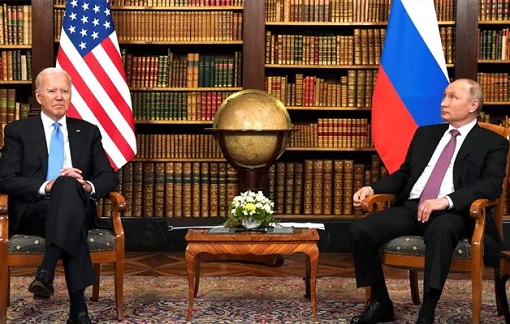
India’s second largest supplier of crude oil is now Saudi Arabia, followed by Iraq in the third spot. Once crude arrives from Russia, India either quickly re-exports or processes it first into diesel and gasoline, and then sells it to European customers like France, Belgium and the Netherlands. In other words, Europe, despite sanctioning Russian oil, is still buying the forbidden Russian oil.
India has 23 oil refineries capable of refining 249 million tonnes of oil a year, making it the world’s fourth-biggest refiner. Asia’s richest person Mukesh Ambani’s Reliance Industries runs the world’s largest refinery in Gujarat, where he has ramped up purchases of Russian oil. Together with India’s second-largest refiner Nayara – of which Russia’s Rosneft owns 49% – Reliance imports 45% of Russian crude.
Clearly, the wishful thinking that sanctions imposed on Russia would cripple and defeat the Kremlin has boomeranged on the Western nations instead. In March last year, President Joe Biden told the world that the war in Ukraine has been “a strategic failure” for Russian President Vladimir Putin. Heck, the U.S. president even mocked that the Russian ruble had been reduced to “rubble”.
However, the opposite has happened instead. Not only Russian ruble has emerged as the best-performing currency in 2022, its economy failed to collapse as trumpeted by Biden and Western media. Worse, the U.S. and NATO, running out of ammunition, are under pressure as Russian continues to rain missiles and “kamikaze drones” in Ukraine.
China, a nation that imports about 70% of its energy, too, has been laughing all the way to the bank since last year – buying Russian oil and selling to Europe. In the same month that Joe Biden mocked the demise of ruble and fantasized how the U.S. could easily beat Putin, China has already started re-selling several U.S. liquefied natural gas shipments to Europe.
Yes, as early as March 2022, China simply re-export to the desperate European Union the same LNG which the Chinese bought from the United States and made huge profits without lifting a finger. At the same time, the Chinese also bought the commodity from Russia before selling it to Europe. Of course, China and Russia were working hand-in-glove by creating a shortage.
Natural gas delivery over pipeline should not be confused with liquefied natural gas (LNG). They are gaseous in different form. LNG is natural gas that is cooled to -260° Fahrenheit, the temperature at which natural gas becomes a liquid, so that they can be transported using special LNG tankers. This is how Europe gets its natural gas after Putin turned off the taps.
Hilariously, not only the West closes one-eye over the Chinese-Russia business trick to profit from Europe’s silly strategic mistake, the British daily newspaper Financial Times had actually praised China as the white knight who saved Europe from a brutal winter last year. And thanks to the Chinese, Europe’s imports of LNG grew 60% year on year within the first six months of 2022.

India, the world’s third-biggest oil-importing and consuming nation, has defended purchases of crude oil from Russia despite criticisms from the U.S. and E.U. Lecturing the West, India said what it buys from Russia in a month is less than what Europe buys from Russia in an afternoon. There’s nothing the U.S. could do to stop its ally India from buying discounted Russian oil.
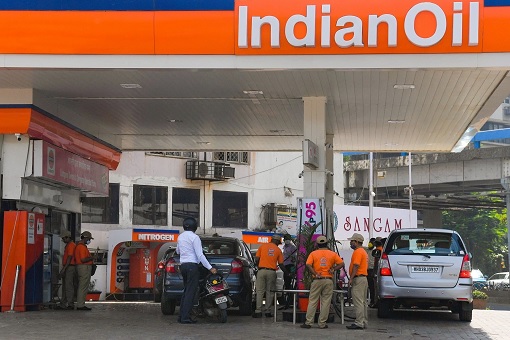
Washington could only urge New Delhi not to buy too much Russian oil. It’s not rocket science to see how China and India are helping the Russian economy at a time when the U.S. desperately wanted to cripple it. The Kremlin isn’t suffering any adverse consequences from Europe’s laughable “sanctions.” Instead of isolating Russia, the sanctions have made China and India top customers of Russia.
To make Russian oil even more difficult to trace, demand for oil storage tanks in Singapore is also surging – suggesting that Russian fuel is being blended with other oil and re-exported. Taking a page from heavily-sanctioned Iran, Moscow has built up a “shadow fleet” of up to 600 old oil tankers to evade Western sanctions.
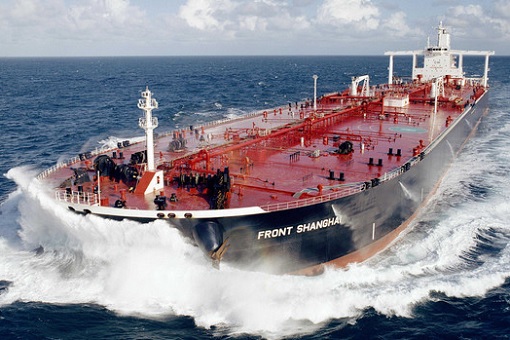
While the West’s 5 largest oil and gas companies – Chevron, ExxonMobil, Shell, BP and TotalEnergies – saw profits skyrocketed to US$195 billion in 2022 (ExxonMobil alone made US$56 billion in net profit), nearly 120% more than the previous year before the Ukraine War began, Europe had to pay US$1 trillion extra last year as a result of surging energy costs.
Besides paying the extra US$1 trillion, both Europe and the U.S. have to fight escalating inflations while achieving none of its embargo objectives. Russia is still funding its war machines today. The energy crisis has triggered not only unnecessary inflations as high as 12% in the United Kingdom last month, but could lead to a recession this year, not to mention triggering de-dollarization.
Europe has merely closed its front door, but quietly opens the back door to welcome Russian oil. But India isn’t the only country taking advantage of the Western’s screw-up. Turkey has also emerged as a top buyer of Russian energy crude oil and coal, with Pakistan and even Bangladesh potentially following suit and ramp up Russian energy imports at discounted prices – and probably resells to the West.
The best part is the European Union had to pretend that the Chinese gas was legitimate and China had saved them – even though the gas originated from Russia. Likewise, the toothless Europe can no longer criticize India’s refusal to condemn Vladimir Putin’s invasion of Ukraine as the 27-nation bloc shifts reliance to India from Russia for gasoline, diesels and jet fuel.
China and India now account for roughly 90% of Russia’s oil. In the first quarter of 2023, Russia’s seaborne crude oil exports totalled 3.5 million barrels per day versus 3.35 million barrels in the previous year. This means Putin has successfully navigated – even defeated – Western sanctions to the extent of exceeding “pre-war” oil exports level. – finance twitter
Fire on “Shadow” Tanker off Malaysia is Extinguished, Search Continues
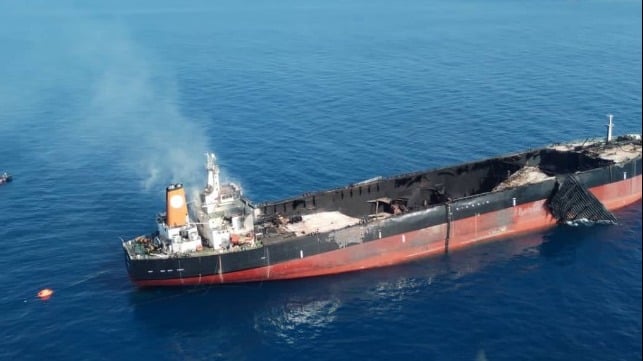
The fire aboard the Aframax crude oil tanker Pablo has been extinguished but the Malaysian authorities are saying it remained too dangerous today to board the vessel to begin their investigation and search for three missing crewmembers. At the same time, investigations are highlighting the vessel’s operation in the shadows. Lloyd’s List is reporting the vessel had four different names, flags, and registered owners in the past four years. The Equasis database shows seven names and owners since 2018, moving between the flags of Cameroon, Cook Islands, Tanzania, and finally Gabon as of April this year.
During a press briefing in Malaysia, the Russian captain of the vessel described the situation saying that he had discovered a fire amidship early afternoon on Monday. The initial discovery of smoke was followed by one or more loud explosions which he said shook the vessel, broke the windows, and rendered most of the communications systems inoperable.
“The fire on the upper deck destroyed our aerial, none of the communication equipment was functioning,” the captain told NST TV in Malaysia. “I had to use the walkie talkie …I finally got in touch with our engineer via the walkie talkie but by then all our safety boats were destroyed.”
The captain said the desperate crew had gone into the water in their life jackets and luckily two ships were in the immediate area to assist with the rescue. He said in the confusion with the crew going in all directions it had been impossible for him to get a head count. He said the fire was also being spread by windy conditions.
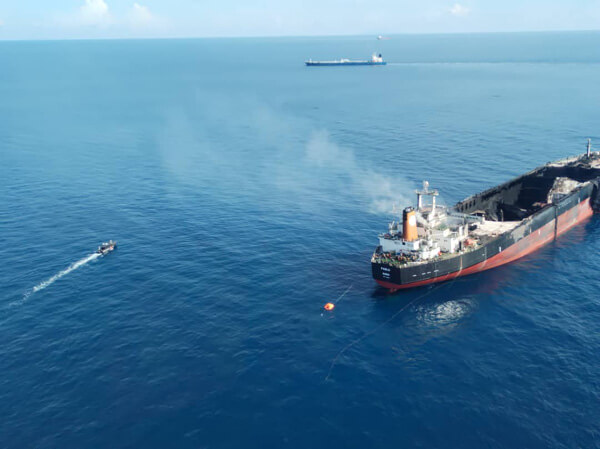
The Malaysian Maritime Enforcement Agency (MMEA) initially reported that 23 crewmembers had been rescued but later revised the count to 25 with three individuals missing. Two are deck fitters and the third is the ship’s personnel officer. The two deck crew are Indian nationals and the officer is from Ukraine. Four crewmembers suffered serious injuries to their hands, legs, and body and were being treated in a hospital.
The MMEA reports that it widened the search area to 71 nautical miles and has dived the search area into four zones. An aircraft and a total of nine vessels are searching involving 136 personnel. The area around the burnt-out tanker has been condoned off but they believe there is no immediate danger to nearby vessels and report that there has been no oil leak detected.
Officials said at least 50 percent of the vessel midship has been destroyed. Pictures show the fuel tanks ripped apart and sections of the deck hanging off the side of the vessel. Experts are saying that the tanks likely had a buildup of fumes and had not been vented causing multiple explosions.
A hazardous materials team is scheduled to board the vessel on Wednesday. The captain is suggesting that the three crewmembers might be locked in airtight rooms and still trapped aboard the vessel. The team will search the ship and look for the cause of the fire.
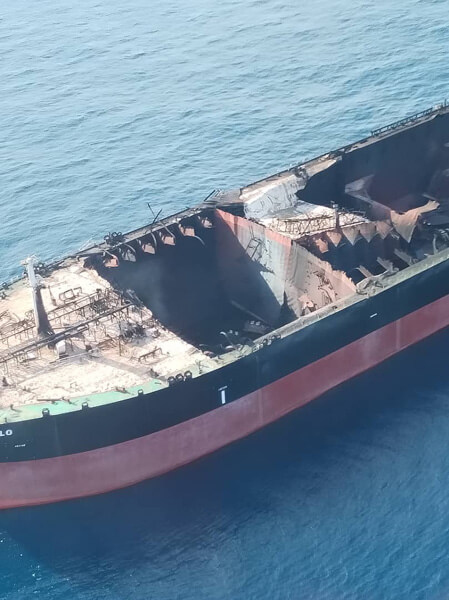
Experts are citing the accident as proof of the danger of the shadow fleet of tankers moving around the world. No insurance has been confirmed for the vessel with the owners remaining a mystery and confusion over which classification society was responsible for the ship.
Claire Jungman, Chief of Staff for the watchdog group United Against Nuclear Iran (UANI) tweeted saying the organization has been tracking the Pablo for many years. “Pablo has been suspected of transporting Iranian oil on at least 10 different occasions since sanctions were re-imposed in 2019. This vessel was operating with no known classification or insurance.”
Analysts are reporting that the Pablo after changing its identity in 2022 loaded Iranian oil which was delivered to China in January 2023. The captain told reporters the vessel had been bound for Singapore and was going to load an oil cargo for transport. It is unclear where the cargo would have been coming from or if they were preparing for a ship-to-ship transfer common in the efforts to avoid the sanctions on Iranian oil. Tanker Trackers is speculating that the Pablo was being positioned to receive a shipment of Iranian oil from a nearby VLCC. – https://maritime-executive.com/
Burning Oil Tanker Off Malaysian Rings Shadow-Fleet Alarm Bells
-
The Gabon-registered ship observed in Iranian waters in 2022
-
Some 25 of 28 crew have been rescued: Singapore authorities
